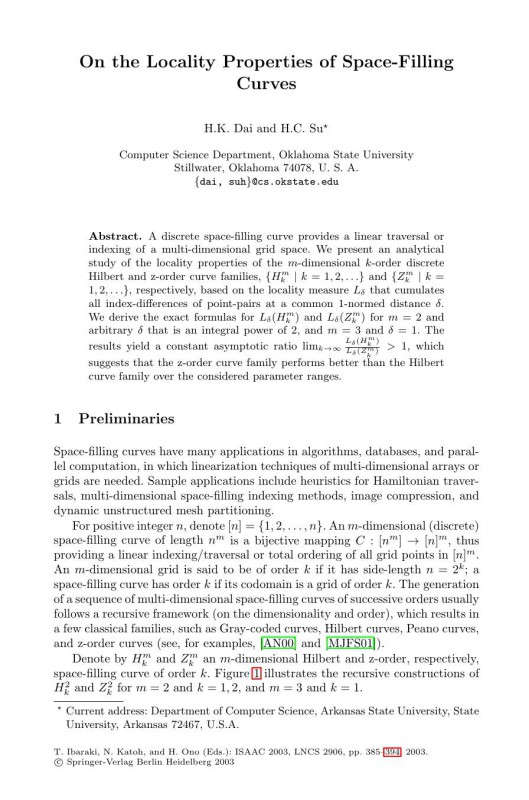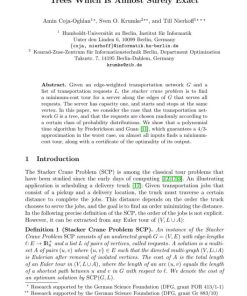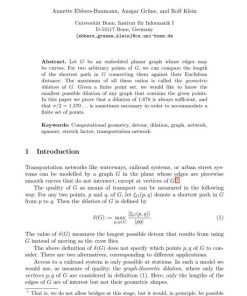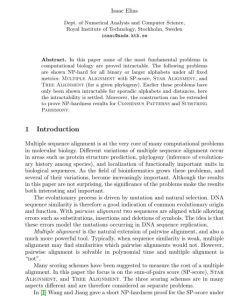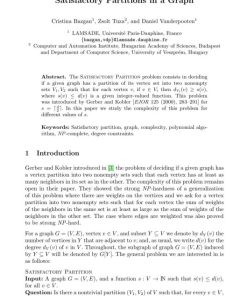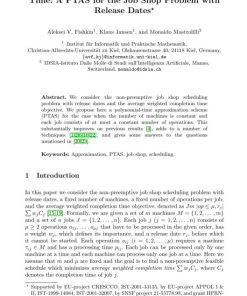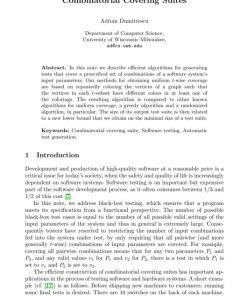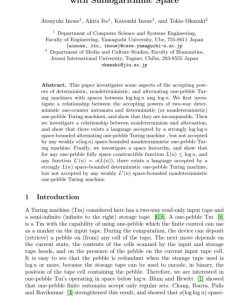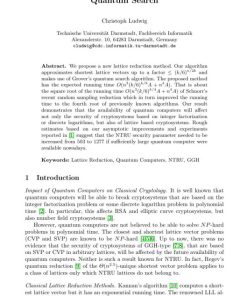On the Locality Properties of Space Filling Curves 1st edition by Dai, Su ISBN 3540206958 9783540206958
$50.00 Original price was: $50.00.$25.00Current price is: $25.00.
Authors:H.K. Dai; H.C. Su , Tags:Algorithms and Computation , Author sort:Dai, H.K. & Su, H.C. , Languages:Languages:eng , Published:Published:Oct 2003
On the Locality Properties of Space Filling Curves 1st edition by H. K. Dai, H. C. Su – Ebook PDF Instant Download/Delivery. 3540206958, 978-3540206958
Full download On the Locality Properties of Space Filling Curves 1st Edition after payment
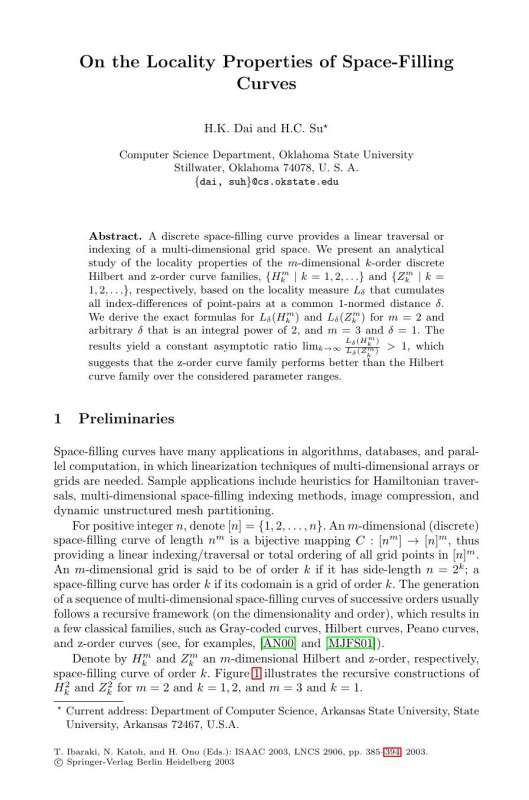
Product details:
ISBN 10: 3540206958
ISBN 13: 978-3540206958
Author: H. K. Dai, H. C. Su
A discrete space-filling curve provides a linear traversal or indexing of a multi-dimensional grid space. We present an analytical study of the locality properties of the m-dimensional k-order discrete Hilbert and z-order curve families, <span id="MathJax-Element-1-Frame" class="MathJax_SVG" style="box-sizing: inherit; display: inline-block; font-style: normal; font-weight: normal; line-height: normal; font-size: 16px; font-size-adjust: none; text-indent: 0px; text-align: left; text-transform: none; letter-spacing: normal; word-spacing: normal; overflow-wrap: normal; white-space: nowrap; float: none; direction: ltr; max-width: none; max-height: none; min-width: 0px; min-height: 0px; border: 0px; padding: 0px; margin: 0px; position: relative;" tabindex="0" role="presentation" data-mathml="{Hkm|k=1,2,…}”>{Hkm|k=1,2,…} and <span id="MathJax-Element-2-Frame" class="MathJax_SVG" style="box-sizing: inherit; display: inline-block; font-style: normal; font-weight: normal; line-height: normal; font-size: 16px; font-size-adjust: none; text-indent: 0px; text-align: left; text-transform: none; letter-spacing: normal; word-spacing: normal; overflow-wrap: normal; white-space: nowrap; float: none; direction: ltr; max-width: none; max-height: none; min-width: 0px; min-height: 0px; border: 0px; padding: 0px; margin: 0px; position: relative;" tabindex="0" role="presentation" data-mathml="{Zkm|k=1,2,…}”>{Zkm|k=1,2,…}, respectively, based on the locality measure L δ that cumulates all index-differences of point-pairs at a common 1-normed distance δ. We derive the exact formulas for L δ (H k m) and L δ (Z k m) for m = 2 and arbitrary δ that is an integral power of 2, and m = 3 and δ = 1. The results yield a constant asymptotic ratio lim<span id="MathJax-Element-3-Frame" class="MathJax_SVG" style="box-sizing: inherit; display: inline-block; font-style: normal; font-weight: normal; line-height: normal; font-size: 16px; font-size-adjust: none; text-indent: 0px; text-align: left; text-transform: none; letter-spacing: normal; word-spacing: normal; overflow-wrap: normal; white-space: nowrap; float: none; direction: ltr; max-width: none; max-height: none; min-width: 0px; min-height: 0px; border: 0px; padding: 0px; margin: 0px; position: relative;" tabindex="0" role="presentation" data-mathml="k→∞Lδ(Hkm)Lδ(Zkm)>1″>k→∞Lδ(Hkm)Lδ(Zkm)>1, which suggests that the z-order curve family performs better than the Hilbert curve family over the considered parameter ranges.
On the Locality Properties of Space Filling Curves 1st Table of contents:
-
Introduction
- 1.1 Overview of Space Filling Curves
- 1.2 The Concept of Locality in Space Filling Curves
- 1.3 Motivation and Applications of Space Filling Curves
- 1.4 Structure of the Paper
-
Preliminaries in Mathematical and Computational Geometry
- 2.1 Basic Definitions and Terminology in Geometry
- 2.2 Representation of Multidimensional Spaces
- 2.3 Types of Space Filling Curves: From Peano to Hilbert
- 2.4 Locality and Continuity in Space Filling Curves
- 2.5 Properties and Characteristics of Space Filling Curves
-
Theoretical Foundation of Space Filling Curves
- 3.1 Formal Definition of Space Filling Curves
- 3.2 Key Properties: Continuity, Surjectivity, and Dimensionality
- 3.3 Multidimensional Extension of Space Filling Curves
- 3.4 Comparison of Different Space Filling Curves (e.g., Hilbert, Z-order, Peano)
- 3.5 Mathematical Analysis of Locality in Space Filling Curves
-
Locality Properties of Space Filling Curves
- 4.1 Definition and Concept of Locality in Curves
- 4.2 Locality and Proximity Preservation
- 4.3 The Relationship Between Spatial Proximity and Curve Proximity
- 4.4 Locality in One-Dimensional vs. Multidimensional Spaces
- 4.5 Bounds and Measures of Locality for Space Filling Curves
-
Locality and Approximation in High Dimensions
- 5.1 Challenges in Multidimensional Space Filling
- 5.2 Locality Preservation in Higher Dimensions
- 5.3 Approximation and Error Bounds in High-Dimensional Space
- 5.4 Space Filling Curves for Data Indexing in High Dimensions
- 5.5 Multi-dimensional Generalizations: Theoretical vs. Practical Considerations
-
Algorithms for Constructing and Analyzing Space Filling Curves
- 6.1 Basic Algorithms for Constructing Space Filling Curves
- 6.2 Efficient Algorithms for High-Dimensional Spaces
- 6.3 Computational Complexity of Space Filling Curve Construction
- 6.4 Algorithms for Analyzing Locality Properties
- 6.5 Approximation Algorithms and Performance Measures
-
Applications of Space Filling Curves
- 7.1 Data Organization and Storage (e.g., Database Indexing)
- 7.2 Image Processing and Compression
- 7.3 Geographic Information Systems (GIS) and Spatial Data
- 7.4 Parallel and Distributed Computing
- 7.5 Machine Learning and Data Mining: Feature Mapping and Dimensionality Reduction
-
Improving Locality in Space Filling Curves
- 8.1 Modifications to Enhance Locality Preservation
- 8.2 Hybrid Space Filling Curves and Their Properties
- 8.3 Adaptive Space Filling Curves: Dynamic Changes in Locality
- 8.4 Locality and Load Balancing in Distributed Systems
- 8.5 Practical Optimization Techniques for Locality Enhancement
-
Advanced Topics in Locality and Space Filling Curves
- 9.1 Locality in Non-Euclidean and Curved Spaces
- 9.2 Space Filling Curves for Randomized Data and Stochastic Processes
- 9.3 The Role of Locality in Geospatial and Temporal Data
- 9.4 Space Filling Curves in Quantum Computing and Information Theory
- 9.5 Statistical and Geometric Analysis of Locality Properties
-
Open Problems and Future Directions
- 10.1 Unresolved Issues in Space Filling Curves and Locality
- 10.2 Theoretical Open Questions in Locality Preservation
- 10.3 New Directions in Algorithm Design for Space Filling Curves
- 10.4 Potential Applications of Space Filling Curves in Emerging Fields
- 10.5 Future Research and Challenges in Computational Geometry
-
Conclusion
- 11.1 Summary of Key Findings on Locality Properties
- 11.2 Contributions to the Understanding of Space Filling Curves
- 11.3 Final Thoughts on Practical Implications and Future Research
People also search for On the Locality Properties of Space Filling Curves 1st:
a locality with an officially organized government
a property of living things
each of the following is a type of lot except
based on the location of nitrogen on the periodic table
e properties and development

